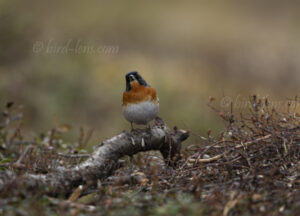 Polyphonic, high-pitched calls resound from the dense tops of a pine forest at the edge of a sports field in southern Brandenburg, only 50 km away from Berlin. The calls can be heard from far away and are characterized by their rather squawking pitch. The birds can be heard from different directions. It must be a really large flock. When I approach a little later, the first sightings confirm that they are Bramblings (Fringilla montifringilla). Probably they are gathering in preparation for migration to the north of the continent, where they live in the Taiga. There may be a good 100 individuals, all hanging out in the upper canopy areas. Only a few Titmice (Parus sp.) can be seen at the edges. I identify 3 Great Tit (Parus major) and 1 Blue Tit (Cyanistes caeruleus). Otherwise, it appears to be a species-only congregation. The association with the Chaffinch (Fringilla coelebs), which can be observed otherwise, does not take place now. All this in cool April weather, sometimes sunshine, sometimes drizzle.
Polyphonic, high-pitched calls resound from the dense tops of a pine forest at the edge of a sports field in southern Brandenburg, only 50 km away from Berlin. The calls can be heard from far away and are characterized by their rather squawking pitch. The birds can be heard from different directions. It must be a really large flock. When I approach a little later, the first sightings confirm that they are Bramblings (Fringilla montifringilla). Probably they are gathering in preparation for migration to the north of the continent, where they live in the Taiga. There may be a good 100 individuals, all hanging out in the upper canopy areas. Only a few Titmice (Parus sp.) can be seen at the edges. I identify 3 Great Tit (Parus major) and 1 Blue Tit (Cyanistes caeruleus). Otherwise, it appears to be a species-only congregation. The association with the Chaffinch (Fringilla coelebs), which can be observed otherwise, does not take place now. All this in cool April weather, sometimes sunshine, sometimes drizzle.
During migration periods, Bramblings mainly stay in open and semi-open areas on farmland and along wooded edges. During influxes in autumn or early winter as well as at the peak of the home migration until mid April, large flocks sometimes appear in Germany. The Bramblings then seem to prefer the low mountain regions and disperse to the beech stands there. bird-lens.com was able to experience this phenomenon once a good 20 years ago in the Siebengebirge near Bonn. In years with rich beech mast, flocks of more than 1,000 Bramblings can be found. Wintering birds prefer to use sparse mixed forests. Despite the lack of snow and thus hardly recognizable food shortage, the pretty, orange-black brambling appeared singly or also in small troops – gladly together with the chaffinch – also at feeding places in the village this winter.
The home migration of the Brambling starts at the end of February and is usually most intense in March. In spring – and this could well be the case for 2022 – the peaks are sometimes not until April due to migration congestion because of harsh weather conditions like heavy wind from the east or north. In most areas, the numbers of birds observed during the spring migration are significantly lower than during the autumn migration. Last observations, then predominantly of single individuals, still occur until mid May. Longer periods of stay in Central Europe are hardly documented. For some time, sometimes hundreds of individuals stay in the area of open spaces, such as farmland. It is reported that roosts are used not only in reeds but mainly in pines and other conifers. This could fit very well with the above observation.
To cope with the growing demand for top shots of the rarer species of the Palearctic, Bird-lens.com is striving to further expand the range of images of birds of the Western Palearctic. Trips to remote locations to capture images of rare birds of the Western Palearctic have been very successful. Likewise, trips to local surroundings always bring nice impressions and sometimes a rare observation, which – if things go well – can also be crowned with photos. The nice picture of the blog was taken in Scandinavia and shows nevertheless quite well the habitat in pine-dominated Brandenburg. The picture is just a first impression, what you can find in the gallery in the “Picture Shop” very soon. Just leave a message if bird-lens.com can help with a picture.